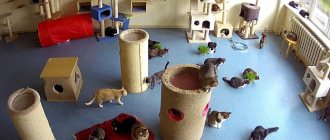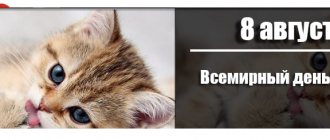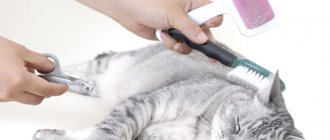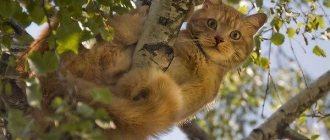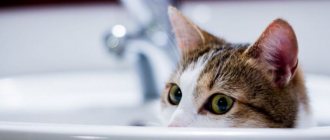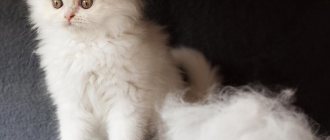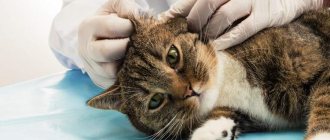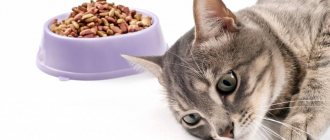Grooming a cat is a specific procedure that most owners prefer to entrust to a professional. However, it is not always possible to find a suitable master or pay him for the work. In some cases, you need to quickly cut your cat’s hair, and you don’t have time to go to a salon, so you have to think about how to carry out the procedure yourself. What are the features of grooming cats at home?
Why cut your cat's hair?
After clipping, the coat is easier to comb.
In fact, the procedure is quite popular and in demand in grooming salons. Yes, there are owners who bring their favorite furry dogs for a haircut in order to win at the exhibition, have an extravagant look and have cute photos for Instagram or social networks.
But there are also those who know that such hairstyles have many advantages for the health of their children. What are the advantages of a unique hygiene procedure?
- getting rid of tangles, which have become too numerous and can no longer be untangled with ordinary brushes;
- normalization of digestion: unsightly and hanging hairballs, disfiguring the cat, can cause blockage of the stomach and intestines if accidentally swallowed during another lick;
- order in the house: after a haircut, the wool does not lie everywhere and does not cause the owner to have bouts of quiet rage when, once again, black pants have turned into a shaggy hedgehog;
- easier combing;
- peace of mind between the cat and the person: you won’t have to tyrannize your pet and freak out from the daily tearing apart of tangled areas of fur;
- relief from suffering: in summer the animal will no longer suffer from the heat.
By the way, the presence of tangles is the cause of dermatological problems: the skin under them heats up more, creating favorable conditions for the development of pathogenic microflora. Frequent formation of “felt balls” indicates a metabolic disorder or vitamin deficiency and requires consultation with a specialist.
What to expect after a haircut
Despite the benefits of grooming for cats, especially those with thick, long hair, there are also negative consequences of this procedure. These points are mainly associated with changes in the structure of the coat. Thus, in tipped and colorpoint breeds, the coat that grows back after trimming becomes two or even four shades darker.
After being trimmed, cats' fur grows back slowly and may never reach its original length.
It is also important that after machine processing of cat fur:
- the fur coat may become thinner and shorter;
- the hairs in the first week after cutting (especially with a 1 mm length nozzle) will be hard and prickly;
- the likelihood of skin damage increases (during playing or scratching, after a long stay in the sun).
In my opinion, grooming a cat is a tedious procedure not only for the owner, but also for the animal. Therefore, it is better not to experiment with your pet unless unnecessary. Being the owner of both long-haired cats and medium-length purring cats, I have always limited myself to thorough combing. With proper care, machine treatment of a pet is not so necessary and is a last resort. And exotic lovers would do well to pay more attention to the psychological comfort of their pet. After all, curly haircuts take a lot of energy from a cat. For mobile or too independent “touchy people”, I would rather not change their image at all.
To cut or not to cut
It is important to understand that not all cats can and should be subjected to this procedure. So the following are a kind of contraindication:
- colorpoint and tipping colors - as the fur grows on the back and belly, it will become several tones darker than before cutting;
- disgusting character and violent temperament, when the animal does not give in to any persuasion. Of course, you can cut it under anesthesia, but in this case, evaluate all the possible risks associated with the administration of narcotic drugs: cardiac arrest, coma, failure of the liver and kidneys. As a last resort, sedatives and muscle relaxants are used instead of drugs, but only after approval of the appropriateness of their use by a specialist and under his clear guidance;
- Without an urgent need, there is no point in cutting short-haired cats - the heat does not particularly interfere with normal life activities, and they never have mats;
- Smooth-haired animals are cut only in extreme cases, for example, when they have been worn in oil paint and it is easier to shave the animal than to try to rub off the matted multi-colored wool.
Which cats should not be cut?
Owners of colorpoint and tipping cats are often interested in the question of whether their pets can be cut. This procedure will not affect their health in any way, but if the cat is a breeding cat, then it should be taken into account that after the haircut, the hair that grows back on the back and belly will be several tones darker.
Animals with a violent temperament that are not amenable to persuasion should not be cut unless absolutely necessary. The same applies to short-haired pets. They are not bothered by the heat, the fur does not tangle, so only if the cat gets very dirty, for example, with oil paint, is it easier to trim it than to wash it.
Tools and accessories
To groom a cat at home, you need to be patient and prepare the necessary equipment in advance. The less fuss and emotions there are, the calmer, faster and without incidents everything will go. So what might you need?
- assistant,
- special trimmer for cats (regular and for hard-to-reach places),
- rounded scissors with blunt ends, it is best to take surgical ones,
- In case of possible injury, prepare peroxide, cotton wool, and brilliant green.
The requirements for the trimmer are:
- quality and reliability;
- power of at least 45 watts. It is especially important to observe this point in relation to Persians, exotics and other owners of luxurious hair with thick undercoat;
- for other breeds, less powerful devices are also suitable;
- sharp blades that actually cut rather than tear out fur;
- the length of the blade is from 2 to 3 cm, otherwise you can accidentally injure the skin, especially if the haircut is carried out by an inexperienced user;
- the device must operate from the network, which guarantees its stable operation without interruption or loss of power;
- It is better if the motor is rotary rather than vibrating. Although this is not important, especially if the cat is cut from time to time.
Instead of an electric unit, you can use the most ordinary mechanical machine. It has a number of advantages:
- lower price,
- absence of unpleasant noise, and therefore the animal will be less nervous,
There are also some disadvantages: the hairstyle may turn out to be asymmetrical, and the process will be lengthy.
In principle, you can trim a cat’s hair at home with simple scissors, especially if you only need to cut off tangles or shape individual areas of the body.
How to trim a cat's fur?
If you decide to groom and don’t know how to cut a cat’s hair at home, then this step-by-step instructions will help you.
Step 1: Choose a place to cut your hair
It is better to groom the animal in a room where there are no carpets. Trying to remove large amounts of cat hair from your carpet with a regular vacuum cleaner can be a pain, not to mention the hairs will clog the dust collector.
Choose a wide window sill or table as your workplace.
Step 2: Prepare the area
Cover a windowsill or table with a couple of old towels or a blanket. This will add a little cushioning, which will make the grooming process more comfortable for the cat, and will protect the surface of the table/window sill from cat scratches.
Find the nearest outlet and plug in the trimmer. The distance should be sufficient to allow the device cord to sag and provide room for maneuver.
Step 3. Bring the cat to the prepared area
Before you begin grooming, let the cat get comfortable in place. Give him a treat and petting him for a few minutes will calm him down and allow you to spot tangles and dirty areas.
Step 4: Remove the claws
To do this, hold the paw in one hand and gently press on the cat's toe to extend the claw. Remove only the sharp tips, avoiding the epithelial tissue that protects the claw.
Clipped Siamese cat
Important! A short-trimmed claw will cause pain in the cat, and damage to the epithelial tissue is traumatic. If you are unable to trim your nails yourself, contact a professional groomer or veterinarian.
Advice! Trim your nails a day or two before trimming. If you do everything at once, the cat will get nervous.
Step 5: Brush your pet
Comb the scruff of the neck, back and belly with a powder brush. You will probably need a helper to gently hold your cat while you brush the belly area. Brush the paws and tail with a wide-tooth comb.
The following steps should be taken if the animal has matted fur or mats:
- Remove tangles using a slicker brush. Hold the matted fur to avoid stretching the skin, which can be very painful for the cat. This will take a few minutes. If you can't comb the problem area of fur, use blunt-tipped scissors to cut it off.
Important! Make sure that when cutting the mat you do not catch the skin with scissors (in cats it is very thin and easily injured).
- Rub a small amount of cornstarch into the problem area and comb it out after a while. This will help dry out the dirt on the coat.
Step 6. Cut the cat's hair
If you want the hairs to be a little longer, cut in the direction of growth of six. In short - against the grain. To create a lion haircut, start from the back and sides. Glide the trimmer in a straight line from the root of the tail to the head.
Attention! Trim carefully, without pinching the skin - this can injure the animal.
After each pass with the machine, remove any hair from the blades. Stop periodically to remove the trimmed fur from the cat. This will make it easier for you to see the missed areas. Keep your cat's skin taut all the time to avoid injury to the skin.
Mei-kun with a lion haircut
After you have trimmed the fur on the back and sides, lay the cat on its side and comb the fur on its belly. While your assistant holds the cat, carefully trim the fur around the nipples, genitals, and the rest of the tummy.
When cutting the tail, leave the fur on only the last quarter of the tail. However, not all cats like to trim this part of their body. Therefore, in order not to irritate the animal, do not cut the tail at all.
The hair on the paws is usually not cut (or down to the knee/elbow joint).
Step 7: Shape your mane
Leave the withers, part of the back and belly uncut - this way you will form a mane “like a lion”. After grooming, wipe the area with a damp cloth to remove any cut fur.
Step 8. Grooming is complete, pet the cat and give him a treat.
Preparing a cat for immobilization
There is a really workable option to immobilize a cat with a clothespin or a paper clip - essentially the same thing. The item is attached to the withers without causing pain or discomfort for the cat. Behavior is inhibited spontaneously and reactions are slowed down. The cat will better tolerate this procedure, provided that it is performed by a person close to him, or better yet, by the owner. Also, manipulation should be carried out only in case of urgent need, and not for fun. Most cats that were tried to be immobilized in this way experienced the action positively, without pain or fear. But no one is immune from the individual reaction of each individual cat.
First you need to prepare the cat for the procedure:
- If the pet is wearing a collar, it must be removed to provide free access to the cat's neck. If left on, it can create a suffocating feeling and your pet will become agitated.
- After this, you need to find the scruff. It is located on the outside of the cat's neck and looks like a loose fold. If it is difficult to feel the cat’s scruff, then it will not be easy to immobilize it. You should be extremely careful not to squeeze your cat's skin too hard.
- You need to grab the scruff of the neck with your hand and look at the pet’s reaction. If he feels completely relaxed, then he can quickly be immobilized. If the animal meows or tries to escape, then you need to try to immobilize it using another method.
You can determine that a cat is tense when he is not trying to escape by dilated pupils, intermittent breathing, and moving ears. If you grab it by the scruff of the neck closer to the ears, you can control the movement of the animal’s head. To avoid needing help when immobilizing a cat, it is better to watch a training video in advance. It's actually simple.
© shutterstock
How to carry out the procedure
The hair on a cat's head is usually not cut.
- The cat is fixed on its side by its hind and front legs.
- If the animal is overly aggressive, a collar is put on the animal to prevent it from biting.
- First they cut the tangles with scissors, and then take the clipper and continue working on the sides and back.
- The fur on the paws is removed last, if necessary at all.
- When working in the abdominal area, exercise maximum caution and carefully avoid the nipples and intimate area. It is better to cut the area around with scissors in advance so that all the delicate parts are clearly visible.
- The hairstyle is not done on the head; in extreme cases, it can be shaped using thinning scissors.
- The tail is cut at will and as the hairdresser's imagination allows.
It is important to carry out all manipulations as carefully as possible so as not to injure the animal. It is not always possible to completely trim an animal at once - do not be upset: even though the procedure will take place in several stages, but all participants in the “acting” will remain safe and sound.
After grooming, the cat should be washed and dried with a hairdryer. Although, to avoid unnecessary stress, you can simply wipe your pet with a damp cloth or suede cloth to remove cut and stuck hairs.
In the cool season, the trimmed miracle needs to be provided with a comfortable indoor microclimate without drafts and the possibility of hypothermia.
Tips for owners
Before grooming your cat at home, remember these important points:
- The nipples, genitals and anus should be trimmed very carefully, holding the cat firmly to the table.
- After a haircut, your pet may change the structure, color and length of its coat.
- You cannot trim your head, mustache or ear hair. If you want to give a neat look to the mane on your head, use thinning nails. Don't remove all the hair from the tail, mostly leave a tassel or whisk at the end.
- Stretch the cat's skin to avoid damaging it.
- You need to comb your cat after grooming with a special fur brush. Afterwards, wash your pet or wipe it with a damp cloth.
- Observe your pet's behavior for several days after the procedure. If you see any alarming changes, consult your veterinarian.
- It is necessary to cut your cat's hair no more than three times a year, as the fur grows back slowly.
How often
Experts recommend cutting your hair several times a year. For ordinary cats, 1-2 times a year is enough, for long-haired cats 3-4 times. Haircutting largely depends on the formation of tangles. The influence of the owner who decided to win with the help of a cat at an exhibition is decisive. But veterinarians do not recommend abusing the procedure.
Long-haired cats can be trimmed before the start of summer to improve heat exchange. For medicinal purposes, the hair is shaved as needed. Let us note some of the nuances that accompany any haircut:
- You cannot cut your head, the hair on your paw pads, and especially your mustache. The fur in the ears performs a protective function. You can't touch her either. Without it, dirt and dust will accumulate in the ears.
- Haircuts often cause the fur to change color after it grows back. It is not recommended to cut cats with kolopoit and tipping. The fur becomes noticeably darker on the back and belly.
- The fur grows back up to six months. Frequent haircuts can cause hair to not grow to the desired length. The coat will become thinner, which is fraught with potential diseases during the winter.
- To be safe, you should trim your cat's claws first. It is worth carrying out the procedure with an assistant.
- Haircut, especially for the first time, is not a quick process . They last at least 2-2.5 hours.
In specialized hairdressing salons, specialists use mild anesthesia. But its frequent use has a negative impact on the pet’s health. It is possible to do a haircut at home without anesthesia.
Popular cat haircuts
There are exhibition and home haircuts. The following hairstyles are ideal for home use:
- lion - all hair is cut off except the head, the tip of the tail and the paws below the “knees” and “elbow”,
- puss in boots in this case leaves fur on the head, tail and the entire surface of the limbs,
- summer
Exhibition or model hairstyles are created by experienced groomers. There are many options for “laying”:
- continental,
- puma,
- harlequin,
- modern,
- the Dragon.
If your plans do not include a cat grooming or the animal stubbornly does not give in to the hairdresser’s onslaught, then you will have to monitor and care for the fur as usual:
- periodic combing,
- timely removal of matted hairs,
- the use of shampoos and conditioners that help soften and straighten the hairs.
Long-haired breeds must be given special products that dissolve tangles in the stomach or use ready-made food that already contains the necessary absorbable ingredients. And to prevent heat stroke, you will have to get an air conditioner.
Well, a video on the topic of how cats are cut in salons:
Model haircuts
Model cat haircuts are more often used for representatives of decorative breeds that take part in exhibitions. Among the variety of creative hairstyles, you can always choose one suitable for a cat of a certain breed, coat length, and color. There are standard models of exhibition haircuts, the technology of which hairdressers can make adjustments to depending on their own creative vision or the wishes of the cat owner.
Types of exclusive model zoo haircuts:
- The French Lion is a spectacular hairstyle, which, along with the Puss in Boots haircut, is a summer option.
- Zebra is a decorative hairstyle, the purpose of which can be both to get rid of excess hair and to participate in fashion shows.
- Modernism is the task of zoo hairstyle to emphasize the exterior features of the animal.
- Continental – professional exhibition haircut.
- Harlequin is an exclusive pet haircut with complex modeling of the coat.
- Salad with beans and carrots - step-by-step recipes for preparing meat or lean meats with photos
- 8 reasons why your hip hurts after sleep
- What haircut will rejuvenate you after 40
a lion
The Leo cat hairstyle is when the hair from the entire body is cut off, except for some areas that imitate the mane, downy boots and a tassel on the tail. The fur is kept on the head, including the neck area. The upper part of the cat's limbs is cut off, leaving fur on the lower parts of the legs. The volume of fur in the area of the head, paws and tail is discussed in advance with the owner of the mustachioed four-legged friend.
Puma
The Puma zoo hairstyle is performed on a similar principle to the Leo option. The volume and length of the sheepskin coat can vary, and the fur on the paws is left in the form of “sock socks” or “socks.” For a puma cut, there are a variety of ponytail treatment options. At the end you can leave only a pointed or flat brush of different lengths and volumes.
The Dragon
Dragon hairstyle requires great professionalism from the master, and patience from the pet. The hair on the head is always kept intact, only light modeling is possible. The fur on a cat's limbs is also a matter of taste. The originality of the cat's haircut in the form of a dragon lies in the “Iroquois” on the back of the animal. Furry islands along the spine may continue all the way to the tip of the tail.
Puss in Boots
The hairstyle fully corresponds to its name, because the cat’s paws are shaped like fluffy boots. The head area and the tip of the tail are trimmed at the request of the pet owner. The body can be shaved completely or cut with fancy patterns in the form of islands of fur. In winter, the coat is simply shortened, while in the summer it is completely shaved off.
How does haircut affect animals?
Is it possible to cut a cat's hair without causing any changes, and how will cutting it at home affect the pet's behavior?
Haircut significantly affects hair growth
Almost all long-haired breeds change coat color, becoming darker or lighter. It happens that haircut significantly affects the growth of fur, sometimes this process accelerates, and in some cases, on the contrary, it becomes slower, and in rare cases it stops growth completely.
Tools for the procedure
If you decide to groom your cat at home, make sure you have all the necessary tools.:
- Ironing board or table;
- A special trimmer or electric razor - if you want to trim your cat with a clipper;
- Regular and thinning scissors (for grooming);
- Iodine and hydrogen peroxide for treating accidental wounds, cuts, scratches;
- An assistant who will hold a struggling cat.
For your own safety and the safety of the table, before carrying out the procedure it is necessary to trim the cat’s claws.
© shutterstock
How to cut a cat's hair at home?
It is better to choose small and convenient scissors as the material at hand. If your pet has thick hair, then it is better to carry out the procedure using a clipper. But usually such devices buzz loudly and scare the animal. Therefore, when choosing a machine, choose the quietest copy. Ideally, this hygienic and aesthetic procedure should be carried out several times a year (4-5 months will be a break). Be sure to trim your pet before the summer heat begins. Animals with thick fur do not tolerate heat well. Make life easier for them and yourself. So, put aside your fear and start cutting hair. Prepare not only a tool (clipper, scissors, comb), but also medications in case of an accidental cut.
Not all cats will be happy with the procedure. Some cats will start screaming, running away and showing aggression at the sight of a clipper and scissors. If you have just such a disobedient pet living in your house, then involve another member of the household in the haircut. You will have to hold the animal's limbs and head with your hands, but do not tie up the unfortunate cat. The haircut usually starts from the sides, then goes to the back, and from there the clippers (scissors) are applied to the tummy. Especially large cleats of wool are initially cut off with scissors, otherwise the attachment for the clipper may break. Yes, and it will be more convenient. The belly should be trimmed carefully and delicately, especially in the nipple area.
To make it more convenient to work, use your fingers to stretch the skin of the cat. This will help you avoid unnecessary cuts. If you get to the paws and tail, but don't leave them completely bare. This way your cute pet will look a little like a lion cub. Of course, you don't need to shave your cat's head either. After grooming, be sure to bathe the animal and dry it with a hairdryer. And don't worry yourself, otherwise your trembling hands will harm the cat.
In this video you can clearly see how a cat is groomed, more professionally, already “with a full hand.” And in the second video, the haircut scene is more interesting, but, let’s say, less professional, although quite acceptable. The main thing here is to know your pet, and if he is restless and can scratch or even bite, then before grooming the cat you need to take measures for your own safety, namely, perform the procedure with an assistant, and approximately as shown in the first video.
Video: Grooming a cat at home
Choosing a cutting tool
The owner often has questions. How and with what do fluffy cats get their hair cut? Is it better to cut hair at home with scissors or a clipper? How to make a beautiful haircut yourself? But first things first.
ATTENTION! Typically, haircuts at home are carried out using regular, sharp, medium-sized scissors.
Sometimes they use a machine, which is undoubtedly convenient, but the loud noise can greatly frighten your four-legged pet. This is perhaps one of the main criteria when choosing a tool. Let's note other devices that are useful for a competent haircut:
- Hydrogen peroxide, iodine, bandage - in case the cat gets hurt while grooming.
- Comb – will allow you to tidy up your cat after grooming.
- A towel or rag that should be placed on the floor or table so that hair is not scattered throughout the apartment.
- If necessary, a toy to distract the cat from grooming.
- Trimmer for cutting hard-to-reach places.
- For haircuts at home, an assistant is most often required. Especially if the cat is not easy to handle.
If scissors are used for cutting, they must have rounded ends. But let’s leave this tool; after all, cutting with scissors requires a certain skill. Let's pay attention to the choice of machine.
The first thing you should pay attention to when purchasing is the price. You shouldn't skimp on cheap machines. It is preferable to buy a more expensive tool that will last longer than a Chinese fake. But not only service life is important. A cheap clipper most often causes pain to the cat by shaving off the hair rather roughly.
If it is not given, then after the first haircut, which will be given with great difficulty, the cat will be afraid not only of the clipper, but also of the haircut in general..
For Persians and other long-haired breeds, you will need a powerful machine. The blades must be sharp and wide enough to effectively remove matted fur. The power of the machine should be at least 45 Watt; for other breeds, 20 Watt is suitable.
The best option would be a machine where you can adjust the size of the blades. Working length – 2-3 cm, with an error of 0.5 mm. Preference in choosing should be given to a machine where you can adjust the size of the blades without replacing them.
ATTENTION! The blades of the machine should not be too small. This is fraught with injury, especially when cutting by an inexperienced user.
To make work easier, the machine must be powered. Batteries have a habit of dying at the most inopportune moments. Working from the network will allow you to properly carry out a haircut at home. Take the necessary breaks and shave for as long as you like.
In extreme cases, a regular mechanical machine will do. Among the minuses, we note the unevenness of the haircut and the long process compared to the electric one. The advantages, of course, are the tolerable price and minimal noise.
Why does a cat need a haircut?
Grooming domestic cats is an element of grooming, which is a set of procedures for caring for the skin of an animal. Since hairdressing services for purrs in our country are just gaining popularity, many owners of furry pets are wondering about the harmlessness of such a procedure. But zoologists assure that haircuts are not only allowed, but sometimes even beneficial for the health of cats. This cannot but please the owners of cats, especially those living in private houses and having access to the outdoors.
Grooming for long-haired cats is a physical necessity
Giving purr fur unusual shapes is becoming popular for two reasons - hygiene and originality. In the first case, a haircut is necessary for long-haired representatives of the cat family - Persian and Angora cats, Siberian and Norwegian forest cats. Otherwise, tangles and sticky pellets will form on pets’ fur coats, causing itching and irritation of the skin. In addition, without proper care, long and thick hair can cause gastrointestinal diseases and constipation.
To create an unusual image, the cat is given a model haircut, characterized by a variety of variations. In this case, the owner of the animal is guided not by the needs of the animal, but by his own ambitions and the desire to emphasize the cat’s individuality.
Other reasons to trim your furry pet's hair may be:
- seasonal increase in air temperature - it becomes difficult for a cat with a thick fur coat to tolerate heat of 35–40 degrees;
- increased work of the endocrine glands - a pet with such dysfunction needs careful hygiene and care;
- intensive molting - the purr still needs to be shown to a veterinarian to identify the cause of excessive hair loss;
- receding hairline in certain areas of the body - a haircut will not solve the problem, so the help of a veterinarian is required.
Despite the apparent benefits of hairdressing procedures for cats, especially those with thick, long hair, haircuts also have disadvantages. Since nature has provided for the natural conditioning of animal skin in all weather conditions (due to cavities in the hairs), unless absolutely necessary, it is better not to get carried away with such a fashionable trend. After all, after removing the fur, the cat’s body temperature also changes, which is why the animal becomes vulnerable to the slightest drafts or exposure to direct sunlight.
I believe that there is no need to cut cats when you can organize proper coat care, but if you can’t, then cut them. In this case, we will not act entirely correctly, but we will not allow the formation of tangles and, as a consequence, the appearance of parasites and skin diseases. As they say, let's choose the lesser evil.
S. Savchenko, veterinarian
https://vetdoc.in.ua/mozhno-li-strich-koshek-sovety-veterinara.htm
If we talk about the frequency of image changes for a domestic cat, then you need to take into account the breed of the animal and the age of the purr. On average, the fur of felines grows within 5 months from the moment of cutting. Therefore, it is best to carry out hairdressing procedures with your pet no more than two to three times a year. And remove tangles as matted wool appears.
Video: why groom cats
Where to cut a cat's hair in Moscow
To perform a hygienic or model haircut, you need to go to a beauty salon for animals. There are a large number of professional hairdressing salons and private hairdressers in Moscow. The advantage of grooming cats in a salon is that professional establishments are equipped with everything necessary to perform hairdressing and beauty services. But they have their drawbacks: a noisy road with many unfamiliar faces, a foreign environment, unusual procedures - this complex of unfavorable factors can affect the mental state of the cat.
The advantages of grooming cats at home are obvious: saving time and effort for the owner, as well as nerves for the pet. An animal at home behaves much calmer, due to the fact that everything around is native, there are no foreign smells and sounds. The only disadvantages include the inability of the master to carry professional equipment with him, but only hairdressing tools.
In the cabin
In the capital's hairdressing salons for animals, in addition to grooming, they provide a wide range of services to improve the appearance of your pet. Moscow salons are equipped with modern specialized equipment, tools and supplies for grooming of any complexity. But while a person who comes to an establishment will definitely appreciate the professionally designed and beautiful interior, then for many representatives of the feline breed any unfamiliar environment causes stress. Considering this circumstance, for particularly impressionable cats it is better to invite a specialist to your home.
- Urinary incontinence in women causes
- A drink that regulates cholesterol levels
- Work experience for a pension - minimum for men and women in Russia, points and special conditions
Professional haircut at home
Grooming long-haired cats at home is especially in demand among residents of megacities due to constant employment. Specially trained groomers are able to find contact with any pet, making the procedure for trimming a cat at home quick and easy. The owner will only have to clean up the cut hair from the floor and console his mustachioed four-legged friend with something tasty.
Grooming a fluffy cat at home (step by step)
The order of manipulations when performing a self-grooming of a long-haired cat is as follows:
- Working tools must be disinfected before use.
- Then you should put “anti-scratch guards” on your pet’s claws (special silicone caps) or trim the claws. To trim, use special nippers, which are available in any pet store - “claw clippers”. Gently press down on the cat's paw and quickly cut off the claws. If the edges turn out uneven, you can trim them with a nail file.
- If your pet is unfamiliar with the procedure and you are not confident in your abilities, it is better to invite an assistant: he will hold the pet and distract him. To protect against bites, place a plastic Elizabethan collar on your cat.
- You can begin the procedure only after the cat is comfortably positioned on its side on the table surface and its paws are securely fixed.
- The haircut starts from the sides. There is no need to rush and be nervous, otherwise your anxiety will be transmitted to your pet and he will also begin to behave restlessly.
- The next stage is the back and stomach. Be careful when handling the stomach. There are mammary glands that can be easily injured. The trimmer movement can be carried out both in the direction of hair growth and in the opposite direction.
- If unnecessary hairs remain after using the trimmer, they can be removed with scissors.
- During the treatment process, try to slightly pull your pet's skin to minimize the risk of cuts. This is especially recommended when the work is done with scissors.
- The tail may be left uncut when trimming is performed for hygienic purposes. But, when the animal is preparing for an exhibition, you can cut it, leaving only a nice tassel at the tip of the tail. It is better to treat the ponytail with a trimmer.
- Upon completion of the haircut, the pet should be washed in warm water with the addition of zoo shampoo and dried. You can use a hairdryer set to a gentle setting with moderate heat.
It's up to you to choose the main tool for cutting your furry pet's hair. At the same time, keep in mind that the trimmer does not always do a good job, and after it you will still have to trim your hair with scissors. And working only with scissors is more dangerous for the cat and significantly lengthens the process, although it guarantees a more attractive appearance for your beauty.
The trimmer can only be used dry! Do not wet the fur under any circumstances if you are going to use an electric trimmer. On the contrary, when working with scissors, it is recommended to slightly moisten the wool, spray it with a spray bottle and distribute the moisture over the wool with a comb. This makes the cutting process easier.
It is not recommended to cut your hair too short, regardless of the breed. Firstly, a haircut that is too short carries the risk of injuring the animal’s skin during the procedure, and secondly, after the haircut, the pet’s normal thermoregulation must be maintained and it should not freeze.
Cat grooming rules
In order to carry out the procedure of grooming a cat at home as painlessly as possible for everyone, you must follow certain rules:
- Having prepared the place and all the necessary tools, the groomer should put on the clothes in which the haircut will be carried out. It is advisable not to leave any exposed skin, as your pet may scratch.
- You should pet and calm the cat, help him get used to the buzzing of the machine. Give sedatives if necessary.
- Then the pet must be thoroughly combed with a fine-toothed comb and then with a fine-toothed comb to determine the length of the haircut. If the hair is not very tangled, then it should be trimmed minimally.
- The animal is placed on its side, and the assistant presses it firmly to the table, fixing the front legs with one hand and the hind legs with the other.
- First, the tangles are cut off with special scissors or a furminator.
- Use small scissors or a trimmer, like manicure scissors, but with rounded ends, to treat hard-to-reach places - armpits, interdigital space, groin area, areas around the nipples.
- Then a 3 mm attachment (2 mm is extremely rare) is installed on the clipper and the main procedure begins. If there were few tangles, then you can get by with large scissors and a comb.
- The sequence of the procedure is always as follows - first the sides, then the back and stomach. The skin on the belly is the most sensitive, while other areas are being cut the animal usually calms down a little and more calmly tolerates the process of trimming the hair in the most unprotected place.
- The tail is processed last. If there is no need, do not touch it at all or carefully remove the most protruding hairs with scissors.
- On the face, if this is not a model haircut, but a hygienic haircut, the hair is not touched.
- If necessary, after completing the main cutting process, you can go through your pet's coat with thinning scissors.
- The cat's hair is cut in the direction of its growth. This lengthens the procedure somewhat, but causes the least discomfort for the pet.
- Only animals that are accustomed to shearing and can easily tolerate the procedure can be quickly trimmed against the direction of hair growth.
- During the process, especially if the pet is nervous, you need to stop, caress and stroke the animal, and talk to it in a soothing tone.
After finishing the grooming, it is better to bathe the cat, dry the fur with a towel and comb it thoroughly, removing excess hair with a massage brush. Now you need to calm the pet down again, praise and caress it, give it a treat or feed it.
Usually in a grooming salon the whole procedure takes 30 minutes at most, but for the owner it can take much longer - an hour or an hour and a half.
